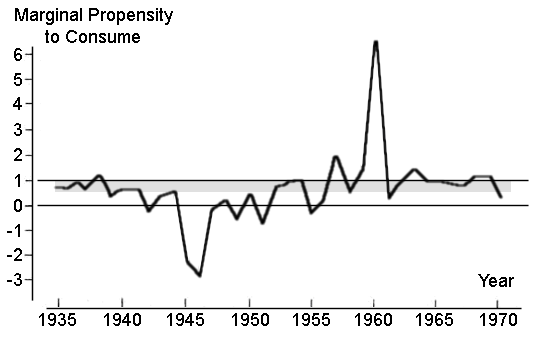A certain Marginal Propensity to Consume MPC gave our late Baron of Tilton the lever by which to lift an economic system into greater comportment with our material longings. His General Theory of 1936 defines this functional relation between income and consumption in rather non-negotiable terms:
Granted, then, that the propensity to consume is a fairly stable function so that, as a rule, the amount of aggregate consumption mainly depends on the amount of aggregate income (both measured in terms of wage-units), changes in the propensity being treated as a secondary influence, what is the normal shape this function?Unfortunately Lord Keynes never revealed how this fundamental psychological law came to be impressed upon his senses; and his followers have been left to wonder just what detailed facts of experience and what inferences he placed at the center of his theory.The fundamental psychological law, upon which we are entitled to depend with great confidence both a priori from knowledge of human nature and from the detailed facts of experience, is that men are disposed, as a rule and on the average, to increase their consumption as their income increases, but not as much as the increase in their income. That is to say if Cw is the amount of consumption and Yw is income (both measured in wage-units) Cw has the same sign as Yw, but is smaller in amount, i.e. Cw/Yw, is positive and less than unity.1
The Neo Keynesian synthesis embodied in Gardner Ackley’s standard text includes the most sympathetic treatment that a ‘constant marginal propensity to consume’ is ever likely to receive. Professor Ackley’s announced purpose is to make a clear statement of as much basic theory as can be generally agreed to. He requires three chapters and 99 pages to make a graduate level exposition of the decision to consume in the presence of an income stream.
Professor Ackley’s initial chapter on consumption theory establishes that 50 or so years of income-versus-consumption data will plot out to a fairly solid line with a slope just less than unity. It is, however,
when we push somewhat deeper below the surface that problems of interpretation continue to raise their ugly heads.2By the end of his third chapter on Keynesian Consumption Theory, Professor Ackley’s exposition of the marginal propensity to consume has descended through qualification, to compromise, and finally to apology. His conclusion is as follows:In many if not most of the contexts in which we wish to apply the consumption function to questions of economic policy, it is the short-run behavior of consumption in which we are interested.3
In this chapter we have demonstrated that the very short-run fluctuations of consumer spending cannot be explained by income changes. On a quarter-to-quarter basis, consumption change is as likely to cause income change as to be the passive result of change in income.4This conclusion is from twenty-two computations of the marginal propensity to consume, based on the consumption and income data from 1948 to 1956. In another reference to these same data Professor Ackley observes that in
. . . only seven cases is the ‘marginal propensity to consume’, as here measured, both positive and less than one. To be sure, the irregularities tend to disappear if we take the movement of six-month or nine-month periods, but not in all cases.5Though his conclusion could not be more feeble, Professor Ackley is yet more robust than might be allowed based on the empirical analysis compiled in the figure below.6

This pedestrian analysis of the marginal propensity to consume is based on yearly series; and it
seems the MPC is at best indifferent as to staying within the range anticipated by Keynes.
Keynes’ rule is established insofar as these data are serially unbiased, i.e.: the series is
symmetric about the expected value for MPC; and deviations from the norm occur randomly in the
dimension of time. But we should also note the data to be rather widely dispersed outside the
range (shaded) anticipated by Keynes. In this respect, Keynes secondary influence[s] would
seem to contain as much of consumers’ behavior as that which he identifies as the primary tendency.
1 J. M. Keynes, 1936; p. 96. The emphasis and interjections are Keynes'.
2 Gardner Ackley, 1971; p. 249.
3 Ibid; p. 253.
4 Ibid; p. 265.
5 Ibid; p. 254.
6 Census Bureau, 1970; Series F26 & F27.